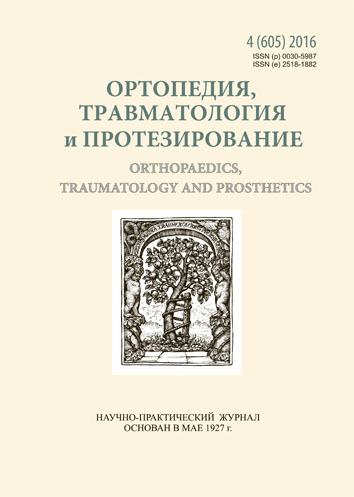Biochemical markers for muscles condition assessment in degenerative spinal deceases (literature review)
DOI:
https://doi.org/10.15674/0030-598720164119-123Keywords:
paravertebral muscles, biochemical markers, creatine phospho¬kinase, aspartate aminotransferase, lactate dehydrogenase, creatinine, myoglobin, lactateAbstract
Objective: to analyze modern laboratory markers of structural and functional disorders of the muscle tissue, which can reflect the energy metabolism and the damage to paravertebral muscles under physiological and pathological processes. We consider the activity of the enzyme creatine as a biochemical marker of muscle status in health and disease. Its activity in serum may increase depending on the degree and duration of exercise in patients suffering from muscle disorders, as well as during exercise, ie. to be an indicator of organism fitness. It is noted that the increase in creatine kinase activity in the assessment of muscle is a favorable prognostic sign. The authors also describe the role of creatinine to assess the functional activity of muscles. Analyze its clinical and diagnostic value as a marker of state violations of muscle tissue in its pathology. It emphasized that creatinine excretion depends on the nature of power. Demonstrated clinical and diagnostic value aspartic aminotransferase activity as an indicator of muscle destruction in myolysis and myopathies. Lactate dehydrogenase activity is considered as a marker of progressive muscular dystrophy. Part of the work devoted to myoglobin as a laboratory marker of muscle tissue state of skeletal muscle injuries, myositis, muscular dystrophy, as well as myolisis criteria during surgical procedures on the skeletal muscles. It is shown that may be indicative of lactate metabolism in muscle loads and hypoxia. It is defined the direction of research on the widespread use of the most informative biochemical marker for the assessment of paravertebral muscle degenerative diseases of the lumbar spine to diagnose metabolic disorders and the effectiveness of conservative and surgical treatment of patients.References
- Kotil K, Tunckale T, Tatar Z, Koldas M, Kural A, Bilge T. Serum creatine phosphokinase activity and histological changes in the multifidus muscle: a prospective randomized controlled comparative study of discectomy with or without retraction. Journal Neurosurg. Spine. 2007;6(2):121–5.
- Hawley JA, Hargreaves M, Zierath JR. Signaling mechanisms in skeletal muscle: role in substrate selection and muscle adaptation. Essays Biochem. 2006;42:1–12.
- Linzer P, Filip M, Jurek P, Šálek T, Gajdoš M, Jarkovský J. Comparison of biochemical response between the minimally invasive and standard open posterior lumbar interbody fusion. Neurol. Neurochir. Pol. 2016;50(1):16–23. doi: 10.1016/j.pjnns.2015.10.008.
- Melnyk AA. Clinical laboratory tests for practice medicine, interpretation. Kyiv: Kniga-plus, 2011. 288 p. (in Russian)
- Rosliy IM, Vodolajskaya MG. Read biochemical analysis rules. Moskow: Medinform, 2010. 96 p. (in Russian)
- Soodan SG, Sandeep K. The relationship between creatine kinase and cortisol level of young Indian male athletes. J Exercise Science Physiotherapy. 2014;10(2):111–3.
- Chirkin AA, Stepanova NA, Gurska AI, et al. Laboratory indicators of metabolic conditions depending on the activity of creatine kinase in male athletes. Bulletin VSU. 2014;4(82):57-63.
- Samsonov AV. human skeletal muscle hypertrophy: a monograph. 2-nd ed. Saint Petersburg. National State University of Physical Culture, Sport and Health of Lesgaft, 2012. 203 p. (in Russian)
- Stogov MV, Lunev SN, Tkachuk EA. Interorganic relationship of energy metabolism substrates in mice for skeletal trauma. Orthopaedic Genius. 2010;(3):40–2. (in Russian)
- Kamyshnikov VS. Clinical and biochemical laboratory diagnostics: a handbook. T. 1. Minsk: Interpresservis, 2003. 495 p. (in Russian)
- Greenhaff PL. The nutritional biochemistry of creatine. J Nutritional Biochemistry. 1997;8(11):610–8. doi: 10.1016/S0955-2863(97)00116-2.
- Komarov FI, Korovkin BF, Men'shikov VV. Biochemical studies in the clinic. Elista: Dzhangar, 1999. 250 p. (in Russian)
- Wright MA, Yang ML, Parsons JA, Westfall JM, Yee AS. Consider muscle disease in children with elevated transaminase. J Am Board Fam Med. 2012;25(4):536–40. doi: 10.3122/jabfm.2012.04.110183.
- Berestovskaya VS, Rebyakova EN. Methods of determining the activity of lactate dehydrogenase. Terra medica nova. 2008;1(17):15–21. (in Russian)
- Tikhilov RM, Andreev DV, Goncharov MY, Shneyder OV. Comparative analysis of biochemical parameters of muscle tissue alteration depending on approaches for total hip arthroplasty. Traumatology and Orthopedics of Russia. 2013;1(67):37–43. doi: 10.21823/2311-2905-2013--1-37-43. (in Russian)
- Magomedov S, Strafun SS, Kravchenko EN, et al. The activity of creatine kinase, lactate and electrolytes in serum and muscles of patients with sequelae of injuries nerves of the upper limb. Annals of Traumatology and Orthopedics. 2012;1-2:111–3. (in Russian)
- Facey A, Irving R, Dilworth L. Overview of lactate metabolism and the implications for athletes. Am J Sports Sci Med. 2013;1(3):42–6. doi: 10.12691/ajssm-1-3-3.
- Belyaeva LA, Korytko OV, Medvedev GA. Biochemistry contraction and relaxation of muscles: a practical guide for students. Gomel, 2009. 64 p. (in Russian)
- Gladden LB. Lactate metabolism: a new paradigm for the third millennium. J Physiol. 2004;558(1):5–30.
Downloads
How to Cite
Issue
Section
License
Copyright (c) 2017 Artem Skidanov, Frieda Leontyeva, Dmytro Morozenko, Valentyn Piontkovsky, Volodymyr Radchenko

This work is licensed under a Creative Commons Attribution 4.0 International License.
The authors retain the right of authorship of their manuscript and pass the journal the right of the first publication of this article, which automatically become available from the date of publication under the terms of Creative Commons Attribution License, which allows others to freely distribute the published manuscript with mandatory linking to authors of the original research and the first publication of this one in this journal.
Authors have the right to enter into a separate supplemental agreement on the additional non-exclusive distribution of manuscript in the form in which it was published by the journal (i.e. to put work in electronic storage of an institution or publish as a part of the book) while maintaining the reference to the first publication of the manuscript in this journal.
The editorial policy of the journal allows authors and encourages manuscript accommodation online (i.e. in storage of an institution or on the personal websites) as before submission of the manuscript to the editorial office, and during its editorial processing because it contributes to productive scientific discussion and positively affects the efficiency and dynamics of the published manuscript citation (see The Effect of Open Access).














